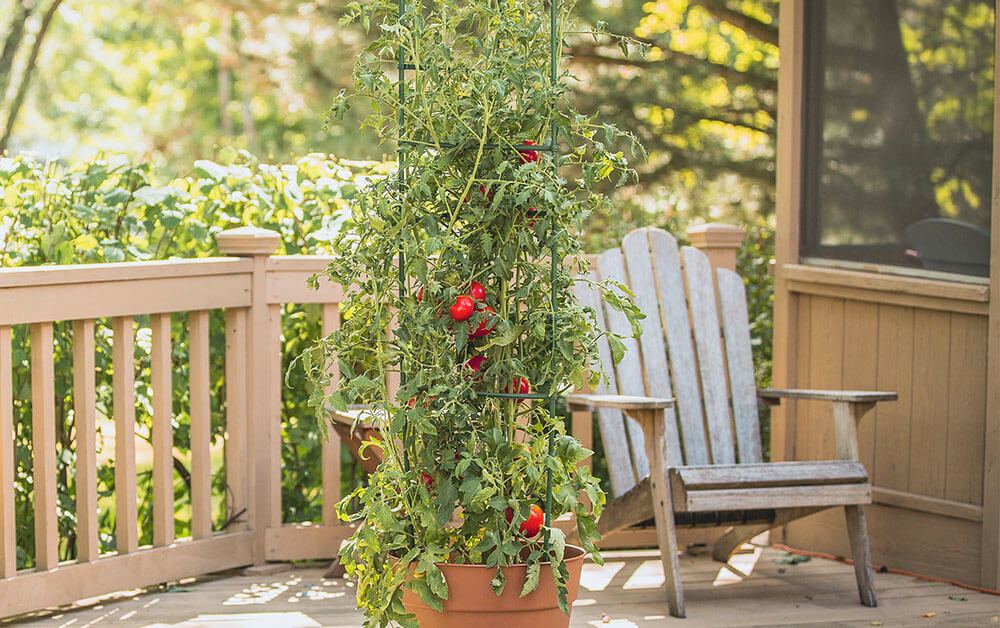
Since the tomato plants are tall and grow upward rather than lay on the ground they need the best tomato cages. They both support tomatoes and provide them with enough sunlight. Besides, this crop has juicy and pulpy stalks that start solidifying only over time that’s why they might break while growing.
It’s important to tie tomatoes up when growing them in either a greenhouse or open ground as the tall (indeterminate) sorts of plants can reach a height of 6 feet. If the plant is breaking under the weight of tomatoes and it continues its cycle on the ground, crop’s nutrition changes and yield decreases, as a result.
The best tomato cages below ensure the stems’ safety and the plant doesn’t have to waste resources on its strengthening. They protect tomatoes from bad weather and facilitate maintenance significantly. For example, it’s necessary to water and spray tomatoes at the roots (they don’t like to have water on their leaves, much fewer chemicals).
Tomato Cages Reviews
Ultomato TMC60 Plant Cage System
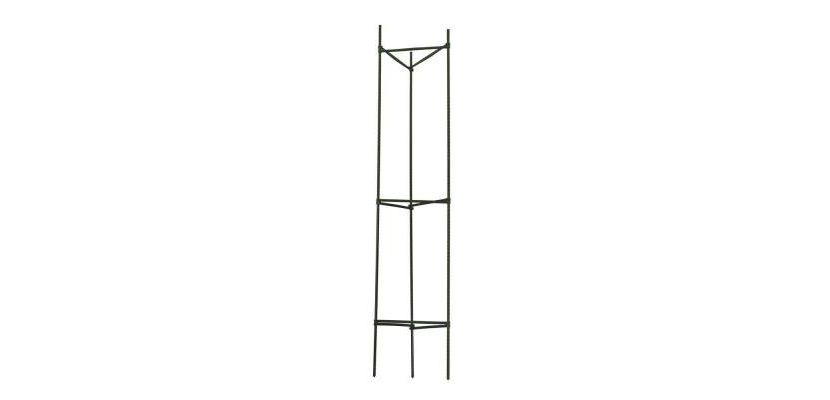
These tomato cages are durable and easy to use. The Ultomato TMC60 is a versatile unit since it fits the whole range of climbing crops and many tall flowers (dahlias or peonies, for example). It’s claimed height is 60 inches, but it’s dependent on how deep a farmer sinks them in the soil.
The cage is made of strong metal with a thick plastic coating. Each item comes with three 5-feet stakes and 9 support clips. The latter is adjustable to change their position according to the plant’s height. Note that the cages aren’t designed to support the crop higher if getting two sets of cages since they can’t be attached vertically. Technically, it’s possible, but the top would be wobbly without jury-rigging additional support.
They don’t really fold, but it’s easy to take the crossbars off and reassemble the whole structure for the next usage. Then, just get a stack of long poles and a bunch of the crossbars. Sometimes the hooks on the ends of the supports break, but it’s easy to find extra packs of them to buy. Make sure to install the support clips on the inside of the uprights and to be able to make easy adjustments by popping the edge with a thumb.
Pros
- Heavy duty tomato cages and they can support even beefsteak tomatoes. However, if it’s necessary to reinforce them, one can use bamboo to that end.
- It looks sturdy enough to last many seasons.
- Green color blends well with vegetation.
Cons
- It would be better to get six or more stakes for really dendritic plants with numerous fruit.
- The stakes don’t have connectors on either end and the plant weight will make it lean.
Gardener’s Supply Company Lifetime Tomato Cages
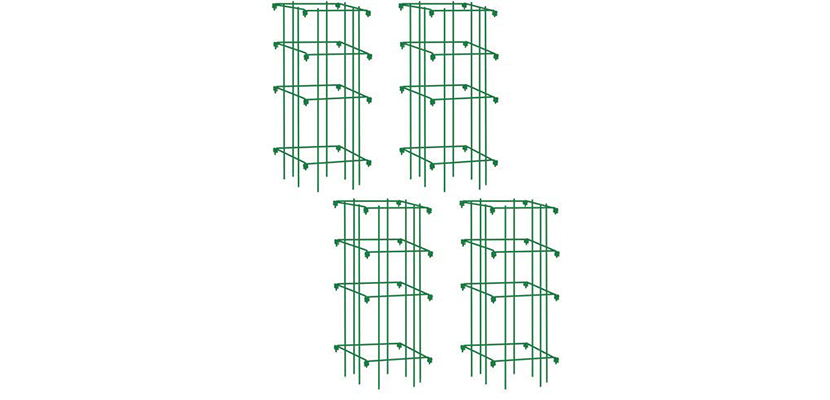
These units can be hardly called tall tomato cages, but they’re heavy-duty items and do not have to be assembled. They fold flat for easy storage. It should be noted that they are much sturdier than the traditional round cages. The units come with 7-inch legs, they’re made of heavy-gauge steel and have a powder-coated paint finish. The latter is smooth to the touch and helps dispense tying the delicate plant stems to them.
Their width is over 14 inches and the height is 39 inches (it reduces up to 32 inches when installing it in the ground). The pieces of this tomato plant cage can be used separately or it’s possible to connect them to form a square cage. The cage’s square shape ensures the plant’s support on all sides, better air circulation, reducing diseases, and keeps the fruit from touching the ground, and thus, remains unblemished.
The stake copes with holding up 6-feet tomato plants in the wind fine. These cages can keep plants from rocking back and forth. Note that they have four segments that hook together so it’s not possible to unhook one and straighten it out in order to use the unit as pea or cucumber fencing.
Pros
- They go into the ground easily without flimsy bending.
- The cages have nice large openings for easy access when harvesting tomatoes. The holes are big enough to get hands through and it’s easy to redirect and weave plants back into their cage.
Cons
- They are perfect for short (determinate) tomatoes, but they don’t fit indeterminate sorts.
- No opportunity to stack them or add an extension on top.
EasyGO Products EGP-GARD-020 Tomato Cages
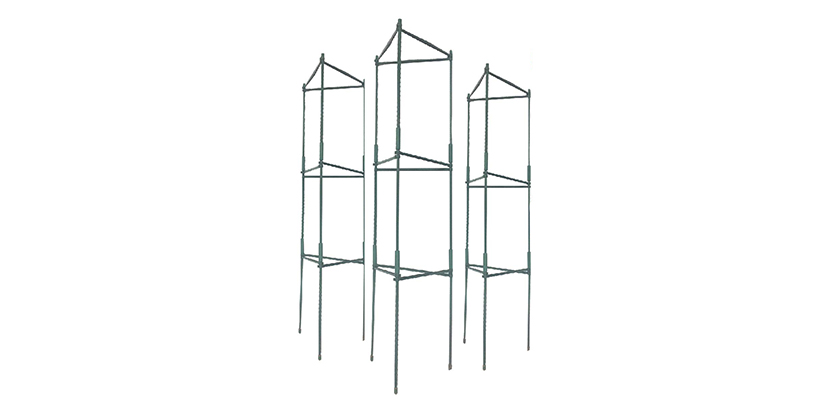
This tomato trellis is adjustable since it’s possible to put them together in different ways. So, it might be any size and one can add more poles and connectors. It results in creating several different types and shapes – a flat trellis, a square, pyramid, rectangle, etc. One can use a steel pipe to reinforce the corner opposite the heaviest part of the plant.
If thinking of, the EasyGO is worthy of attention. Each cage reaches 60 inches with 12-inch horizontal bars. It has 9 Snap-on arms for each of the three trellis structures. The length of the support straps/connectors is 8 inches. The stakes come apart and lay flat for storage. No tools are required to assemble or disassemble the stakes. Besides, each fence can withstand several growing seasons.
Pros
- The unit is lightweight and it snaps together in minutes.
- It’s good when branches grow out of the cage. Just remove a cross brace, put the branch back in and replace cross brace.
Cons
- The tomato trellis is made of plastic that’s why it’s a bit flimsy if speaking of squash plants.
- The stakes are strong enough, but the arms could be more durable.
Panacea Products 89733 Heavy Duty Tomato Cage
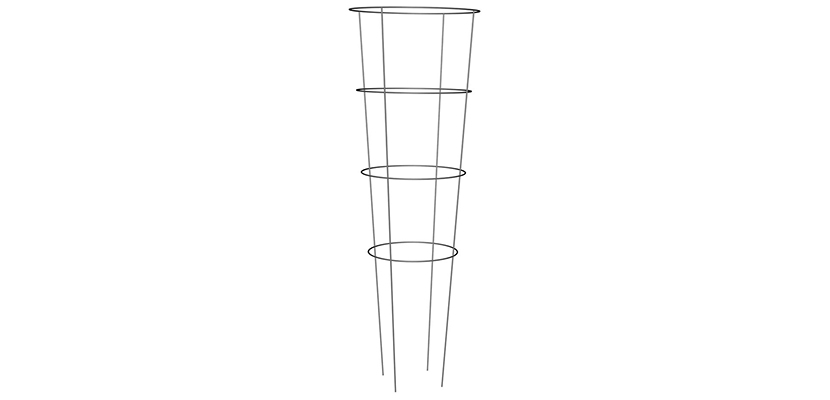
This tomato tower provides space to flourish and keeps tomatoes nicely contained. It is very tall (54 inches), thick, and heavy-duty since it’s made of heavy gauge, zinc-plated (galvanized) steel wire that ensures good resistance to mechanical damage. These sturdy tomato cages also feature strong welds and muscles.
It holds up tomatoes well in normal and not sandy soil even if the plants are large and bushy. If having heavy clay soil (even if it’s thoroughly amended), it’s possible to cut about 4 inches off the legs of the cage and they’ll work great.
These come with three legs and three rings. They are helpful for growing tomatoes, squash, and other similar veggies. When growing small or midsize tomatoes and aiming to make them sturdier, one can cut off 1/3 of the bottom legs.
Pros
- It fits both containers and potted gardening.
- The unit is stackable and easy to store.
Cons
- The welds are sloppy and it’s necessary to wear gloves and be careful when handling because of the small sharp spurs at the weld sides.
Gardener’s Supply Company Square Heavy Gauge Extra Tall Tomato Cage
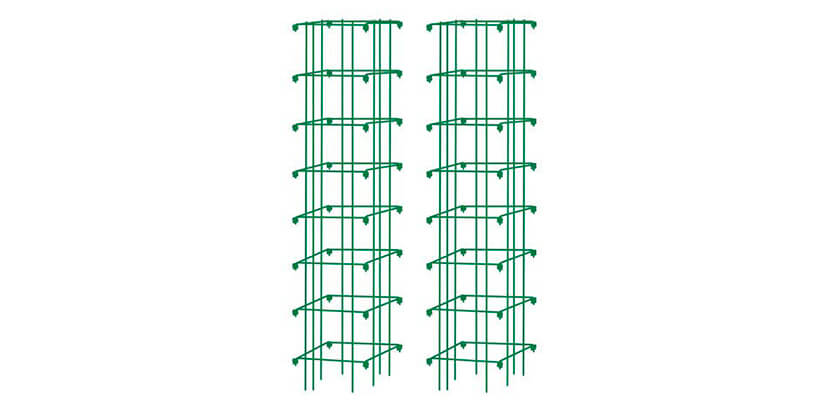
The tomato stand is made of powder-coated steel. It’s sturdy and can be used not only for tomato plants but also for string beans. The product is one of the tallest (65 inches) and the most durable cages on the market. The plants might grow higher, but in this case, just place an 8-feet stake down the center to make plants grow straight. Some gardeners try to use three cages units instead of two, but in this case, it would topple over.
These large tomato cages come in four pieces, as in two double-tall cages in one box. They are unassembled, but it’s very easy to put the parts together since each unit comes in two pieces and the top portion just slides over the bottom. The top portion fits into the bottom one via a tube coupling. The top section has a tube that slides over the bottom section post.
The tomato plant support opens up to install already huge tomato plants around. However, it would be a frustrating process to try to put them around an already-existing large plant and close them around at every level. To that end, somebody should help handle this issue.
To secure this cage to the ground, the spokes at the bottom can be helpful. It’s also possible to acquire long staples that will anchor the cages down.
Pros
- These tomato baskets hold up indeterminate tomatoes without bending or drooping.
- They have large openings for hands to reach through the holes for getting fruit.
Cons
- These tomato ladders cannot be unfolded into a straight panel without support since they might not stay together without help.
Buyer’s Guide
Staking Tomatoes Correctly
Some people still use simple tomato stakes (it deals with either titan, wooden, or metal stick) that they insert at planting time and tie them every 8–10 inches along the stem. Such a straightforward approach is a good solution for tight spaces and square-foot gardens. Besides, they are very cheap and easy to store. However, stakes require heavy pruning that reduces the amount of fruit per plant.
If having compact but not very tight space, it’s better to support tomatoes with the tomato ladders that should be installed while the plant is small. Even as the plants still need occasional pruning, such ladders provide easy access for it.
If speaking of the square tomato cages, it should be placed over the plant pushing uprights firmly into the soil. The towers are the tallest cages and one should use them for staking indeterminate tomatoes. Unlike stakes and ladders, both common cages and towers let the gardener escape tying the plants.
Supporting Tomato Plants Well
How to handle the process if using stakes (in the form of sticks) or ladders?
- Just move gently nearby branches to within uprights.
- Tie the stalk to the upright for secure tomato support.
- Remove suckers and any flower clusters to let the plant direct energy to roots.
Whatever the modification of the tomato stakes in use, make the following steps.
- Make a berm of soil around each plant.
- Fill the center with water and let it soak in the soil.
- Cut off leaves that touch the ground.
Besides, It would be great to add two or three layers of straw mulch to hold moisture, escape splashing up the soil on the leaves, and discourage weeds.
Tying isn’t required since the tomato plant will grow inside what is essentially a cage. The stems will drape over the connecting rods (the horizontal pieces). If the plants are very tall, one should consider making trellises several sections high (3 or 4 ones). As the plant grows, it intertwines in the trellis. It’s possible to move the tomato vines as they grow to spread them out.
Tips on Tying up Tomatoes
It’s necessary to tie up tomatoes sprouts in 15–20 days after they have been planted. To that end, use only eco-friendly materials – garden clips, bandages or nylon band. To tie the stem to a stake, it’s also possible to use hook-and-loop, twine tape or any other soft material (for example, a torn-up old cotton t-shirt or old pantyhose).
While the plant is growing, it’s necessary to continue tying stems to stake and the tomato stand. The gardeners have to repeat the procedure from 2 up to 7 times per season (it depends on the sort and the individual growth of each bush). Consider some rules while tying the plant to the cage:
- The tape or band shouldn’t be over-tightened. Otherwise, it can dig into the stalk and kill the plant.
- Tie the tape/ribbon to the stake firmly.
- Wrap the stem easily and fix the tape (tie a knot).
- Choose the distance at your own discretion but no less than 4–6 inches.
If dealing with numerous tomato bushes in the garden and they are planted in rows, it’s better to use the tomato fence – thin bars or strong stakes that are installed at the beginning and at the end of the tomato patch and stretched wire between them at a height of 6 –6.5 feet. The approximate distance between the rows of wires is 5.9 inches. The tomato plants are tied up to that wire using the materials mentioned above. In the case of the long patch, it’s possible to reinforce the fence with the intermediate stakes.
How to Choose and Install Tomato Cages?
First, it’s necessary to choose the right model of the cage. If growing short potted plants, decent and cheap tomato cages will do their job. However, in the case of long indeterminate bushes, the good crop depends on high-quality units of proper design.
It’s possible to make a crafted cage or to acquire ready-to-use units. Consider the height of the cage that should reach 5 or even 6 feet. Their diameter is also meaningful. It should be in the range of 12–30 inches to provide enough space for the plant.
When installing the cage in the ground, it’s important to make sure that the sprout is in the center of the unit to let vines and leaves extend outside of the cage equally on all sides. Be careful to avoid damaging roots. Push down the cage to bury in the soil until it will be stable and not wobbly. Use a hammer if it’s difficult to handle the task manually.
Then, check the cages for the right distance between them – at least 4 feet. While the plant is growing, trim dead or damaged leaves to keep the green shoots safe. When the season is over and the harvest is ended, pull the cages out and store them for the next year.